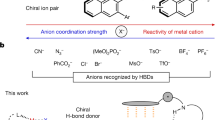Abstract
Conventional chiral ligands rely on the use of a covalently constructed, single chiral molecule embedded with coordinative functional groups. Here, we report a new strategy for the design of a chiral ligand for asymmetric transition-metal catalysis; our approach is based on the development of an achiral cationic ammonium–phosphine hybrid ligand paired with a chiral binaphtholate anion. This ion-paired chiral ligand imparts a remarkable stereocontrolling ability to its palladium complex, which catalyses a highly enantioselective allylic alkylation of α-nitrocarboxylates. By exploiting the possible combinations of the achiral onium entities with suitable coordinative functionalities and readily available chiral acids, this approach should contribute to the development of a broad range of metal-catalysed, stereoselective chemical transformations.
This is a preview of subscription content, access via your institution
Access options
Subscribe to this journal
Receive 12 print issues and online access
$259.00 per year
only $21.58 per issue
Buy this article
- Purchase on Springer Link
- Instant access to full article PDF
Prices may be subject to local taxes which are calculated during checkout




Similar content being viewed by others
References
Jacobsen, E. N., Pfaltz, A. & Yamamoto, H. (eds) Comprehensive Asymmetric Catalysis, and Supplements 1 and 2 (Springer, 1999, 2004).
Yoon, T. P. & Jacobsen, E. N. Privileged chiral catalysts. Science 299, 1691–1693 (2003).
Wiester, M. J., Ulmann, P. A. & Mirkin, C. A. Enzyme mimics based upon supramolecular coordination chemistry. Angew. Chem. Int. Ed. 50, 114–137 (2011).
Breit, B. Catalysts through self-assembly for combinatorial homogeneous catalysis. Pure Appl. Chem. 80, 855–860 (2008).
Meeuwissen, J. & Reek, J. N. H. Supramolecular catalysis beyond enzyme mimics. Nature Chem. 2, 615–621 (2010).
Dydio, P., Rubay, C., Gadzikwa, T., Lutz, M. & Reek, J. N. H. ‘Cofactor’-controlled enantioselective catalysis. J. Am. Chem. Soc. 133, 17176–17179 (2011).
van Leeuwen, P. W. N. M., Rivillo, D., Raynal, M. & Freixa, Z. Enantioselective supramolecular catalysis induced by remote chiral diols. J. Am. Chem. Soc. 133, 18562–18565 (2011).
Hamilton, G. L., Kang, E. J., Mba, M. & Toste, F. D. A powerful chiral counterion strategy for asymmetric transition metal catalysis. Science 317, 496–499 (2007).
Mukherjee, S. & List, B. Chiral counteranions in asymmetric transition-metal catalysis: highly enantioselective Pd/Brønsted acid-catalyzed direct α-allylation of aldehydes. J. Am. Chem. Soc. 129, 11336–11337 (2007).
Liao, S. & List, B. Asymmetric counteranion-directed transition-metal catalysis: enantioselective epoxidation of alkenes with manganese(III) salen phosphate complexes. Angew. Chem. Int. Ed. 49, 628–631 (2010).
Jiang, G. & List, B. Direct asymmetric α-allylation of aldehydes with simple allylic alcohols enabled by the concerted action of three different catalysts. Angew. Chem. Int. Ed. 50, 9471–9474 (2011).
Jiang, G., Halder, R., Fang, Y. & List, B. A highly enantioselective Overman rearrangement through asymmetric counteranion-directed palladium catalysis. Angew. Chem. Int. Ed. 50, 9752–9755 (2011).
Okano, T., Harada, N. & Kiji, J. Transition metal phosphine complexes possessing phase transfer function. Preparation and reactivities of palladium complexes containing quaternary ammonium groups. Chem. Lett. 23, 1057–1060 (1994).
Chisholm, D. M. & McIndoe, J. S. Charged ligands for catalyst immobilisation and analysis. Dalton Trans. 3933–3945 (2008).
Yuan, H., Zhou, Z., Xiao, J., Liang, L. & Dai, L. Preparation of quarternary ammonium salt-tagged ferrocenylphosphine–imine ligands and their application to palladium-catalyzed asymmetric allylic substitution. Tetrahedron: Asymmetry 21, 1874–1884 (2010).
Sawamura, M., Nakayama, Y., Tang, W.-M. & Ito, Y. Enantioselective allylation of nitro group-stabilized carbanions catalyzed by chiral crown ether phosphine–palladium complexes. J. Org. Chem. 61, 9090–9096 (1996).
Shipchandler, M. T. The utility of nitroacetic acid and its esters in organic synthesis. Synthesis 666–686 (1979).
Trost, B. M. & Van Vranken, D. L. Asymmetric transition metal-catalyzed allylic alkylations. Chem. Rev. 96, 395–422 (1996).
Trost, B. M. & Crawley, M. L. Asymmetric transition-metal-catalyzed allylic alkylations: applications in total synthesis. Chem. Rev. 103, 2921–2943 (2003).
Mohr, J. T. & Stoltz, B. M. Enantioselective Tsuji allylations. Chem. Asian J. 2, 1476–1491 (2007).
Lu, Z. & Ma, S. Metal-catalyzed enantioselective allylation in asymmetric synthesis. Angew. Chem. Int. Ed. 47, 258–297 (2008).
Nakoji, M., Kanayama, T., Okino, T. & Takemoto, Y. Chiral phosphine-free Pd-mediated asymmetric allylation of prochiral enolate with a chiral phase-transfer catalyst. Org. Lett. 3, 3329–3331 (2001).
Cativiela, C. & Díaz-de-Villegas, M. D. Recent progress on the stereoselective synthesis of acyclic quaternary α-amino acids. Tetrahedron: Asymmetry 18, 569–623 (2007).
Amatore, C. & Jutand, A. Role of dba in the reactivity of palladium(0) complexes generated in situ from mixtures of Pd(dba)2 and phosphines. Coord. Chem. Rev. 178–180, 511–528 (1998).
Guillaneux, D., Zhao, S.-H., Samuel, O., Rainford, D. & Kagan, H. B. Nonlinear effects in asymmetric catalysis. J. Am. Chem. Soc. 116, 9430–9439 (1994).
Acknowledgements
Financial support was provided by the Funding Program for Next Generation World-Leading Researchers from JSPS (GR050) and the Global COE Program in Chemistry of Nagoya University.
Author information
Authors and Affiliations
Contributions
K.O. and T.O. conceived and designed the study, and co-wrote the paper. K.O., M.I. and T.K. performed the experiments and analysed the data. All authors discussed the results and commented on the manuscript.
Corresponding author
Ethics declarations
Competing interests
The authors declare no competing financial interests.
Supplementary information
Supplementary information
Supplementary information (PDF 4203 kb)
Supplementary information
Crystallographic data for compound 3b. (CIF 23 kb)
Rights and permissions
About this article
Cite this article
Ohmatsu, K., Ito, M., Kunieda, T. et al. Ion-paired chiral ligands for asymmetric palladium catalysis. Nature Chem 4, 473–477 (2012). https://doi.org/10.1038/nchem.1311
Received:
Accepted:
Published:
Issue Date:
DOI: https://doi.org/10.1038/nchem.1311
This article is cited by
-
Cationic Organic Catalysts or Ligands in Concert with Metal Catalysts
Topics in Current Chemistry (2019)
-
Ligand-enabled multiple absolute stereocontrol in metal-catalysed cycloaddition for construction of contiguous all-carbon quaternary stereocentres
Nature Chemistry (2014)
-
Reflections on stereochemistry
Nature Chemistry (2013)
-
The progression of chiral anions from concepts to applications in asymmetric catalysis
Nature Chemistry (2012)
-
The power of pairing
Nature Chemistry (2012)



